Frontend Architecture Newsletter
Get notified about new articles, talks, and updates directly to your inbox.
How I Use the Bullet Journal Method to Stay Organized
As a freelancer and digital nomad, staying organized is essential to my productivity and peace of mind. After trying countless digital tools and apps, I found myself returning to an analog system that has transformed how I work and live: the Bullet Journal methodOpen in a new tab.
What is the Bullet Journal Method?
The Bullet Journal (or BuJo for short) is an analog organization system created by Ryder CarrollOpen in a new tab. It's a customizable and smart system that can work for anyone, regardless of how organized (or disorganized) you naturally are.
The Bullet Journal method is about the art of intentional living.
At its core, the Bullet Journal method is a mindfulness practice disguised as a productivity system. It's designed to help you:
- Track the past
- Organize the present
- Plan for the future
My Bullet Journal Setup
My journal setup has evolved over the time I've been using it to fit my specific needs as a freelancer who travels frequently. Here's how I structure mine:
1. Legend
The legend is the key to understanding your Bullet Journal. It shows all the symbols and their meanings, making it easy to quickly scan your journal and understand what each entry represents. I keep mine simple with the core symbols, but you can customize yours with additional signifiers that make sense for your specific needs.
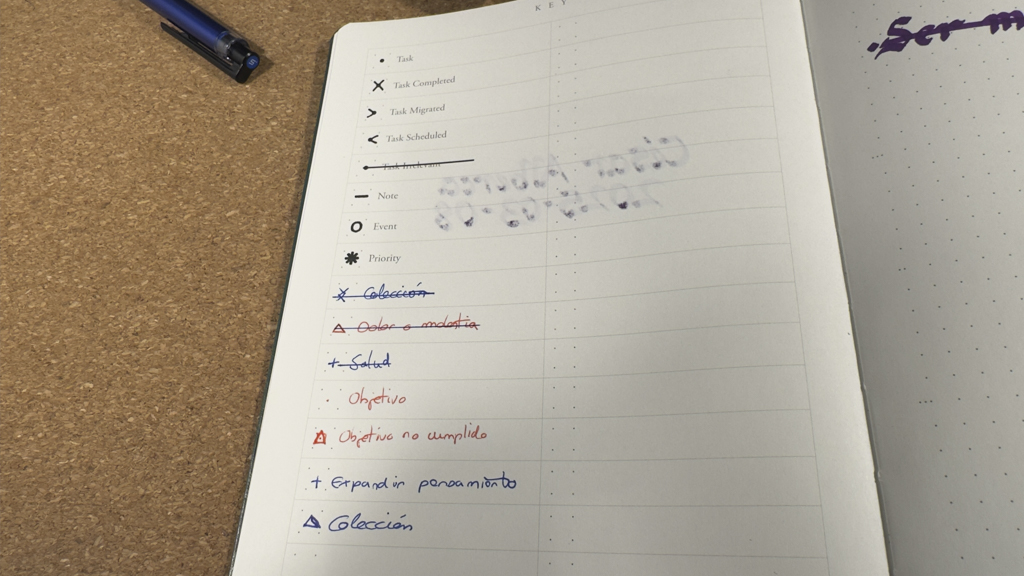
Basic Bullets
- • Task (a simple bullet)
- x Completed task
- • Irrelevant task
- > Migrated task (moved to another day/week)
- < Scheduled task (moved to the weekly log)
- - Note (simple information)
- ○ Event (something that happened)
My Custom Signifiers
- ▵ Collection
- + Expand thought
- = Emotion
- • Objective
- ! Unmet Objective
2. Index
Every Bullet Journal starts with an index. This is simply a table of contents that helps you find information quickly. I update this as I add new collections or important pages.

If a collection spans multiple pages, you can do the following:
Bullet Journaling: 15-16, 18-19
Which means that the trip to Bullet Journaling goes from page 15 to 16 and then again from page 18 to 19. You can also mark in the bottom of the page 16 of the collection a slash and indicate what page it continues to, in this case it would be 16/18. And you can do the same for the page 18, so it would be 16/18.
The index works since the journal I have has numbered pages, so I recommend you buy a notebook that has this feature. Right now I'm using the official oneOpen in a new tab since it's very well-designed for this purpose.
3. Future Log
The future log is a calendar that spans several months. I use it to note important days I want to remember that have already happened. Each month I move days I want to remember here to have an easy overview of the year. I also mark in red birthdays.
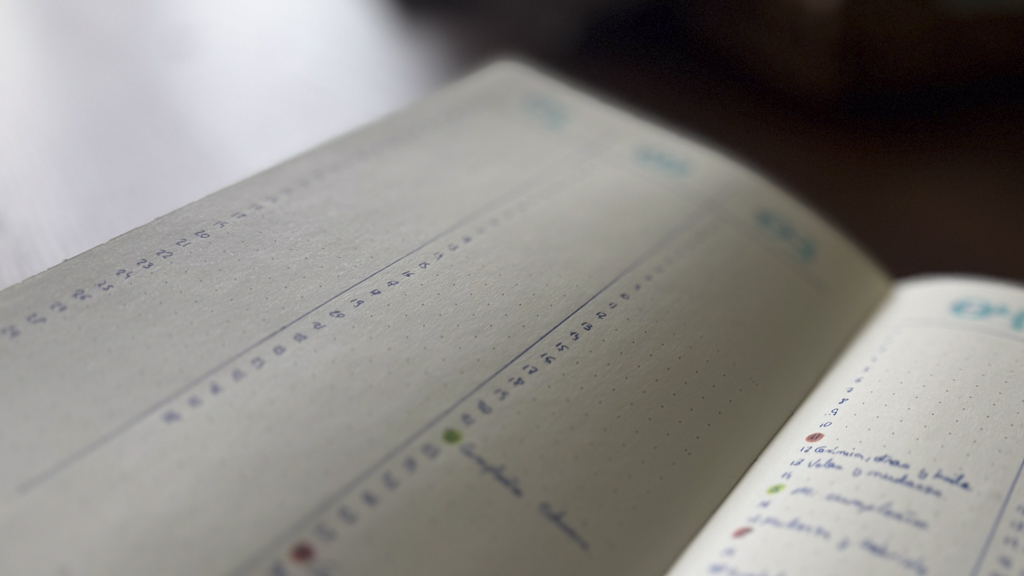
This spread gives me a bird's-eye view of the entire year, making it easier to review what has happened. I find it's a great way to combat the feeling of not doing enough things, especially when I'm feeling overwhelmed.
4. Monthly Log
The monthly log is the heart of my Bullet Journal system. It gives me a complete overview of the month and helps me plan and track my progress. A well-designed monthly log combines calendar elements with space for goals, tasks, and habit tracking.
At the beginning of each month, I create:
- A monthly calendar
- Monthly goals
- Habit tracker
- Feelings tracker
Setting Up the Monthly Log
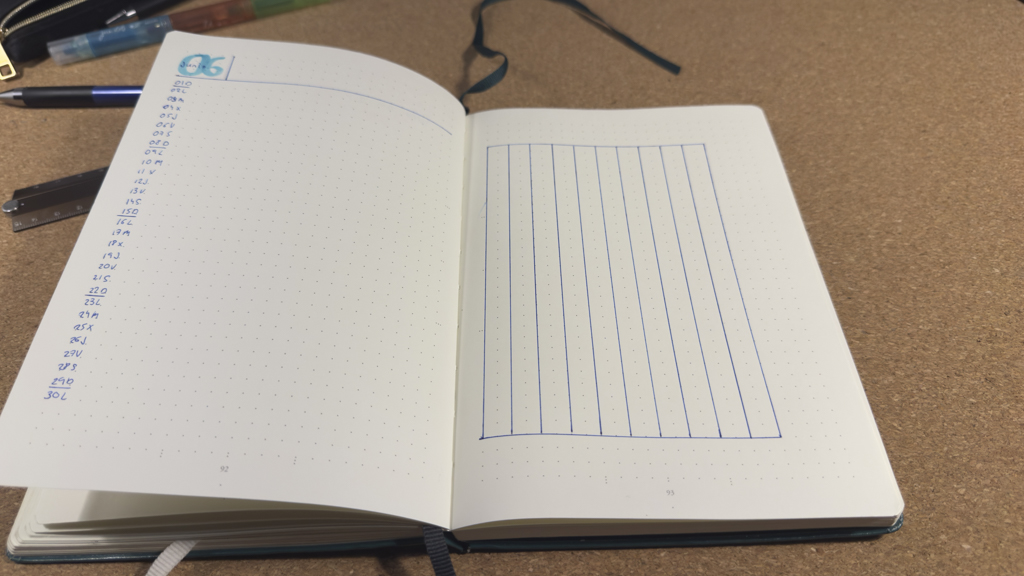
I start with a clean spread that includes dates down the left side and space for notes on the right, and on the second page I set up a feeling tracker, which is aligned to each day. This minimalist approach gives me flexibility to add what's most important for the month ahead. I add the days of the week and a horizontal bar to separate each week, creating a clear visual structure.
Adding Monthly Objectives
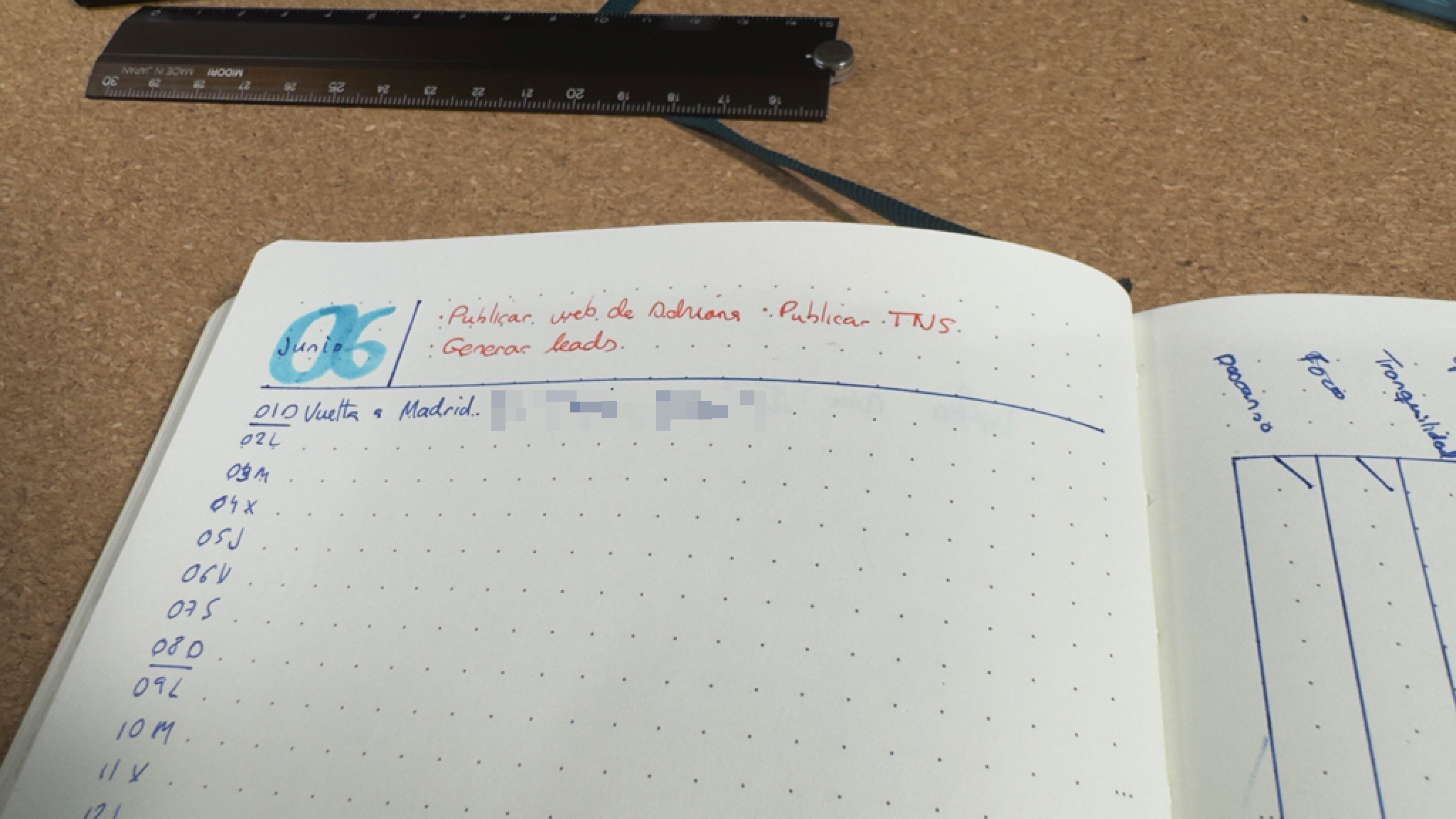
For each month, I set specific objectives that I want to accomplish. Writing these down at the beginning of the month helps me stay focused on what matters most and gives me a clear target to work toward. I typically limit myself to 2–4 key objectives to ensure they remain achievable.
Tracking Daily Habits
My habit tracker is one of the most valuable parts of my Bullet Journal. I track daily habits like meditation, reading, and handstand practice. The visual representation makes it satisfying to fill in each day and helps me identify patterns in my behavior.
Feeling Tracker
Sometimes I get lost in my thoughts or the tasks at hand, since I'm very productivity oriented (this post should have given you a hint!). With this tool I make sure I create a space even if it's small, to sit down and reflect on what's going on. I track the following areas:
- Rest
- Focus
- Calmness
- Exercise
- Self-demand
- Spirituality
- Personal Development
- Economy
And I also track "Work time" and "Personal time". I use red if it hasn't felt satisfying, green if it has, and blue if it was very satisfying.
![]()
As the days go by and I keep joining the dots, there's a graph. If the lines are close to the left it means I'm not feeling well. If they're close to the right, I'm feeling great. The cool thing is that I can see correlations with each day, since I can see how my habits, feelings, and highlights are linked to each day.
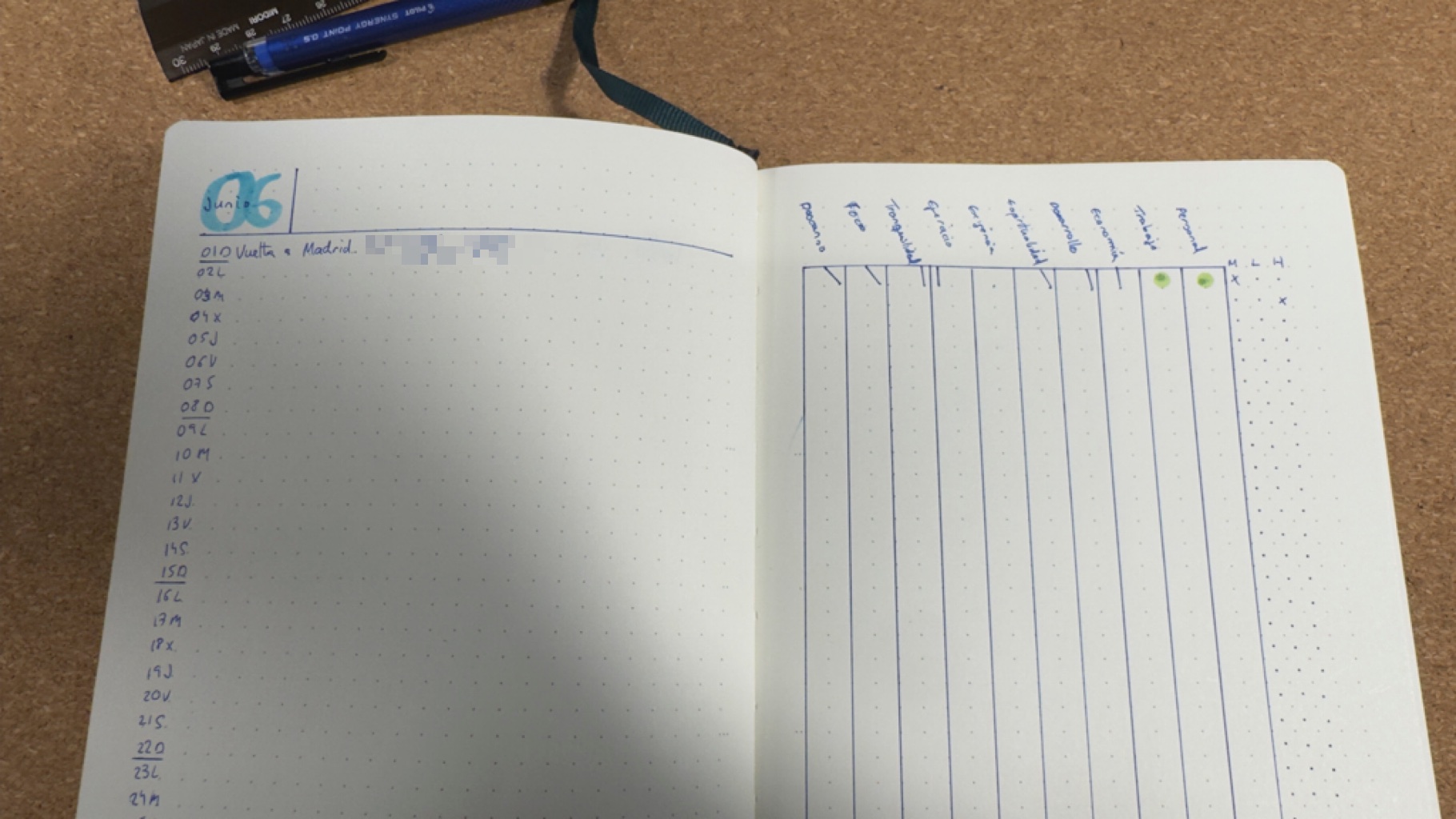
The Complete Picture
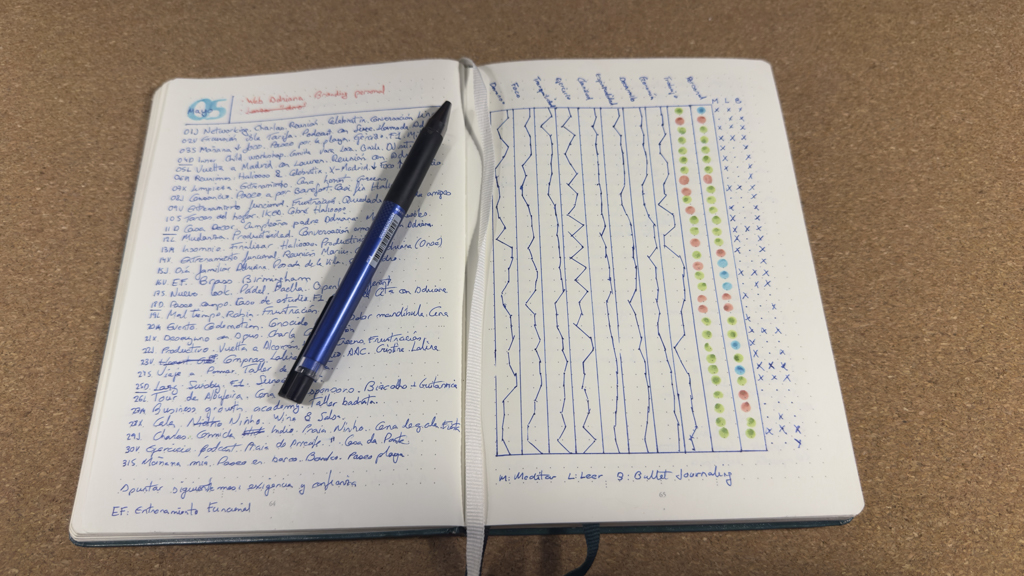
This is how a complete month looks. In a simple glance I can see:
- Highlights of each day
- How I felt during the month and how it's linked to each day
- Objectives of the month and if I completed them
- Habits I completed
- Whether my work and personal time felt satisfying
5. Weekly Spreads
This is a custom module that I found useful for my weekly planning. I had the challenge of organizing myself each week, since I wanted to schedule tasks ahead of time. I didn't want to use the future log for this, since there's not too much space there for things and I didn't want to add things there that might change. What I like about the weekly spread is that I can schedule tasks ahead of time and also reschedule them if needed with arrows.
- Daily task lists
- Weekly priorities
- Weekly objectives
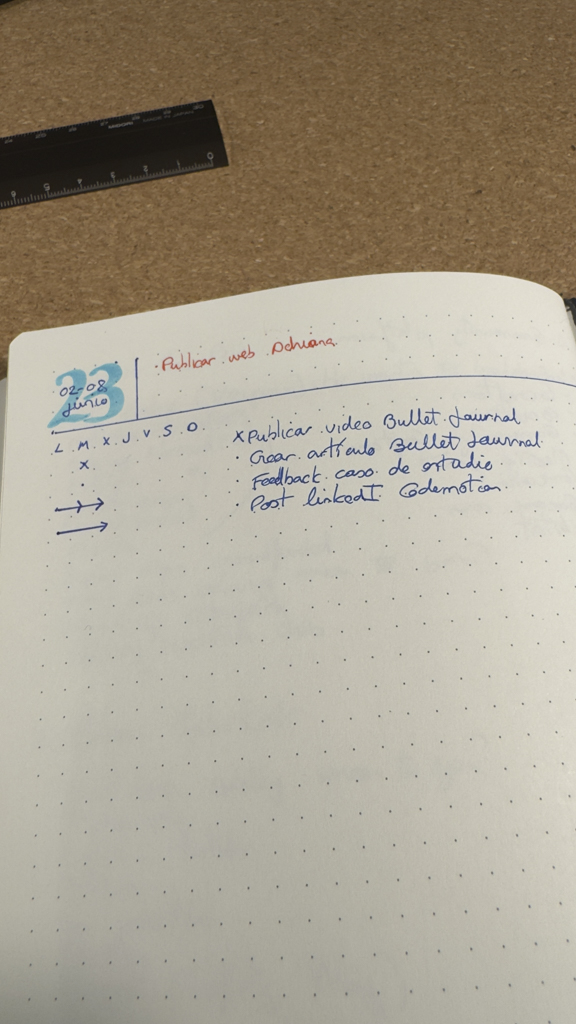
Here's what my weekly log looks like after I've filled it in. If I have a task in my daily log and I want to move to the weekly log, I can do so by marking the task with a caret (>).
6. Daily Log
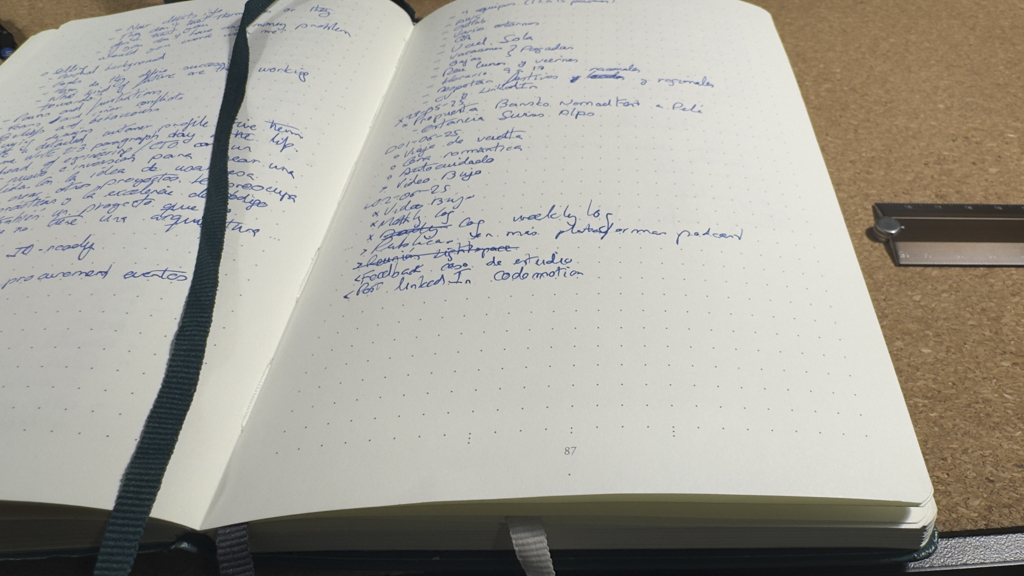
The daily log is where you are going to take most of your notes. This is where I capture the day-to-day tasks, events, and notes that make up my life. The power of the daily log lies in its simplicity and flexibility.
How I Structure My Daily Logs
Each day gets its own section where I:
- Start with the date - I write the date at the top of each daily log section (M02-06-2025)
- Add events - Meetings, calls, and appointments
- List tasks for the day - I use the bullet point system to distinguish between tasks, notes, and events
- Rapid log throughout the day - I add thoughts, ideas, and new tasks as they come up
- Review at day's end - I mark completed tasks, migrate unfinished ones, and add any final notes
If I need to, I can also nest items inside other items.
7. Collections
Collections are pages dedicated to specific topics. Some of my regular collections include:
- Project Logs: One page per client project to track progress, ideas, and notes
- Content Ideas: Blog post and talk ideas that come to mind
- Travel Plans: Details for upcoming trips
- Bullet Journal: Ideas and resources for the Bullet Journal method
Why the Bullet Journal Works for Me
As someone who works with digital tools all day, there's something refreshing about stepping away from screens and using pen and paper. Here's why I find it so effective:
- Mindfulness: The act of writing by hand forces me to slow down and be more intentional about what I include.
- Flexibility: Unlike pre-printed planners or rigid apps, I can adapt my journal to my changing needs.
- Reduced Digital Distractions: When I open a digital app to add a task, I often get distracted by notifications. With my journal, there's no risk of falling into a social media rabbit hole.
- Better Memory Retention: Research shows that writing by hand improves memory and understanding compared to typing.
- Satisfaction: There's a unique satisfaction in physically crossing off completed tasks.
Digital Complements
While I love my analog journal, I do use some digital tools alongside it:
Google CalendarOpen in a new tab for scheduling meetings and time-specific events
NotionOpen in a new tab for collaborative project documentation
Google DriveOpen in a new tab for document storage
The key is finding the right balance between analog and digital tools that works for your specific needs.
Getting Started with Bullet Journaling
If you're interested in trying the Bullet Journal method, here's my advice:
- Start simple: Don't try to create an elaborate system right away. Begin with the basics: index, future log, monthly log, and daily logs.
- Forget perfection: Your journal doesn't need to look beautiful. Focus on functionality first.
- Experiment: Try different layouts and collections to see what works for you.
- Be consistent: Make journaling a daily habit, even if it's just for a few minutes.
- Adapt: The beauty of the Bullet Journal is that you can change it as you go. If something isn't working, try a different approach.
Conclusion
The Bullet Journal method has become an essential part of my productivity system as a freelancer and digital nomad. It helps me stay organized, focused, and mindful in a world full of distractions.
What I love most about this method is that it's not just about getting things done—it's about intentionally deciding what's worth doing in the first place.
Have you tried bullet journaling? I'd love to hear about your experiences or answer any questions you might have!